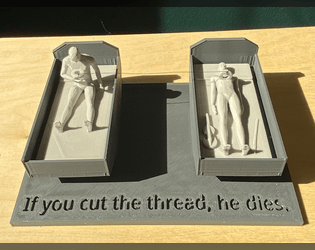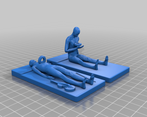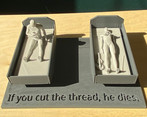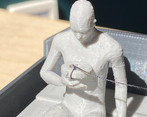This is a powerful representation, like wbmattis2 said. One thing I really like about this representation is that the same 3-d model can be re-used, and so the strings that are left of cut or uncut can be seen by students who might wonder how many others share their moral sentiments. I'll have to see if there is a 3-d printer on campus!
Play activity set
The Famous Violinist's itch.io pageWhat work(s) of philosophy does your piece take as its primary source(s)?
Thomson, Judith Jarvis. A Defense of Abortion.
Please tell us about your piece.
The Famous Violinist is a 3D-printable activity set that allows learners to interact with a thought experiment from Judith Jarvis Thomson's 1971 paper “A Defense of Abortion”.
What other sources have you used in your piece?
http://N/A
Comments
Yes—I love that I can bring them out every semester!
It can be a bit tedious and irritating to restring the cut models, depending on what you use to tie them… I was using embroidery floss, which is finicky, and I will probably switch to a nice chunky yarn for next semester.
It is great that they can see what other students have chosen, agreed—but even better is that they are FORCED to choose themselves. When I teach thought experiments without the models, there are always a few students who don’t seem to pay very close attention, perhaps just because they have trouble imagining the case. And there are others, too, who tend to waffle around rather than get serious about what they would actually do, but the models really focus everyone on the scenario. And whether or not they’ve been interacted with (string cut or scissors set deliberately aside) let’s me know when the whole class is ready for the next part of the lesson, in which they all now have a stake.
(Next semester, I will ask students who decide not to cut actually bring their scissors back up to the front so I have a clear indicator both ways when they are finished.)
It's important not to underestimate the effect of illustrating a thought experiment with a physical representation such as this; I imagine it may prove helpful for students who might otherwise tend to see such thought experiments as irrelevant and/or unbelievable. Do you feel like you gained a new intellectual or visceral appreciation for Thomson's scenario as you crafted each detail of the characters involved?
That is a great question. This is Eli Shupe, answering this in my capacity as project lead; I’m sure some of the students might have different perspectives, but they’re all cramming for their final exams at the moment…
I think the materiality of the model in some ways makes it harder to break the connection—the violinist is right there for you to look at, after all, and you have to physically sever the connection yourself, not just affirm it would be permissible to do so. I am not sure whether this changes anything for me personally, because I have never been very comfortable severing the connection, at least not in the version of the thought experiment where it’s only nine months’ confinement.
I wonder if having the model makes it easier to imagine the violinist but simultaneously harder to identify with the kidnap victim, who is now a representation in front of you that you are being asked to identify with, rather than your very own body. If one is very good at imagining things, and simulating scenarios from the first person perspective, then in some ways the activity set might decrease the immediacy of the dilemma.
My colleague Dr Charles Hermes tells me that experiencing the case with the models does change his intuitions—I will link him this dialogue and see if he’s willing to share more about that.
Here’s how the model changed my view on the argument:
Like many of us I came across this thought experiment ages ago in undergrad. At that point I think the fact that it was an argument that helped the pro-choice movement caused me to be less critical of it than I ought to have been. Also, at that point I was in a much worse position to evaluate any philosophical argument than I am today.
Especially in the last six years I felt less and less sure of my position because I do think our obligations to each other and our community certainly gives us some obligations to the violinist. But, still every time I taught the case I tend to think the argument basically works. So, until very recently I thought staying was supererogatory
This semester that changed because of the model. I think I held onto my earlier view simply because of the phenomenon of belief persistence. By seeing the model the argument was presented to me in a different way than I normally conceived of it. I think the novel presentation caused me to see it as a new problem so it weakened the belief persistence that made me resistant to change my view. While this summer semester I thought the argument worked, this semester I don’t. The change came I think from how the model helped break through biases of belief persistence.
For me, at least, when I spend time concentrating on different models from the Make Philosophy project they always cause different psychological responses to the cases than when not thinking through the model. I been spending a lot of time this semester thinking of the psychological differences between thinking of the cases with and without physical models.
Hi, there! For some reason, I'm unable to generate a link for you to be able to vote in the competition. I see your URL is a bit different from others' -- it has an itch.io/profile/username format instead of a username.itch.io format. Could I ask you to modify your account registration in such a way that it takes the username.itch.io format? I believe you can do so if you go to your account settings and choose a unique URL for your profile. If this isn't possible for whatever reason, we can find another solution. :)
Regardless, here's the voting information:
Please give only one 5-star rating to a single project -- that is, please vote only once, for your very favorite project, that isn't your own. This is to ensure that the popular winner doesn't go to the project that happens to be rated the most times.
Voting will close when the counter on the jam page reaches zero, at 23:59/11:59PM CET/GMT+1 on December 12th, 2022! Your vote will not be made public until the full results for the competition are announced on December 15th on the jam page and on the jam community board.
While you can only vote for one submission, please leave as many comments as you like on all the submissions that strike your fancy! This goes for anyone who entered the jam or who stumbles upon it on the site, even if they didn't submit anything or can't vote! It'd be wonderful to get some good discussions going. If you're not sure where to start with evaluating projects, I've prepared a list of questions to ask yourself as you explore and reflect upon your experiences with each one here. I hope they're helpful to you!
As always, if you have any questions, please either reply to this message or post on the jam's FAQ here. Thank you!









Leave a comment
Log in with itch.io to leave a comment.